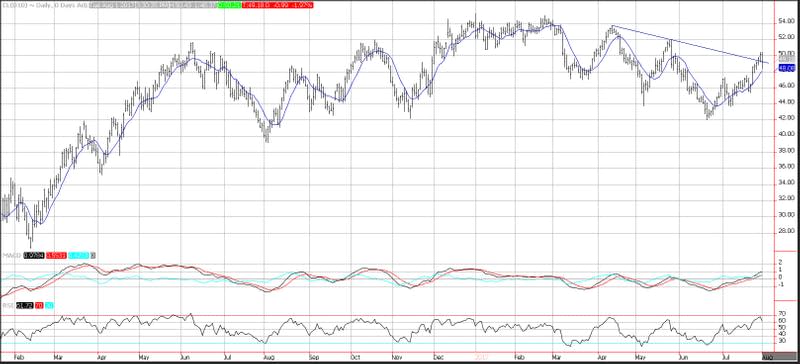Crude Oil Price Analysis for August 2, 2017
Oil prices rose to $50.43, a fresh 2-month high but then reversed course, dropping nearly $2 per barrel, ahead of the API and EIA inventory reports, scheduled for Tuesday evening and Wednesday morning in the Eastern time zone. Prices moved lower on reports that OPEC had exported more than initially thought. Prices were initially buoyed following news that the United States would officially announce sanctions on the Venezuelan President.
Technicals
Crude oil prices whipsawed generating an outside day which is a reversal day that generally comes at the end of a trend. A higher high a lower low and a lower close where the close is below the prior days low, usually foreshadows lower prices. Prices had broken out above trend line resistance, but Tuesday’s close back below that level generates uncertainty. On the bright side, prices were able to hold support near the 10-day moving average at 48.08, coming approximately 30 cents from that level. Resistance is seen near the daily highs at 50.43. Positive momentum was rejected and has started to decelerate. The RSI tested the 70 level, which coincided with Aprils highs, and is moving lower which reflects decelerating positive momentum.

OPEC’s Export Increase in July
Reports show that OPEC’s exported increased by 388K barrels to reach 26.68 million barrels a day last month. The UAE, led the increase shipping nearly 326K barrels a day, which was followed by increases from Nigeria and Libya. While on the face of it this appeared to be a robust climb, it offsets the drop seen in June, and is flat from May. Exports from Libya increased to 907K barrels per day, which climbed nearly 200K from June.
Kuwait saw a dip in exports last month, with shipments down by 241,000 barrels per day. Saudi Arabia’s shipments of crude fell by 45,000 barrels per day last month to 7.155 million bpd. The Kingdom has pledged to cut its oil exports further, to 6.6 million barrels from this month. If this is the case, inventories in the United States will shrink.
OPEC had agreed to reduce overall supply by 1.2 million barrels a day, but Libya and Nigeria have proved a challenge as they were exempt because of militant activity. Now this activity has largely subsided, and both have been pumping more. Nigeria promised to stop ramping up production once it hit 1.8 million bpd, but Libya has not made any such promises.
U.S. announces Sanction on Venezuelan President
U.S. announces sanctions on Venezuelan President, after Venezuela moved forward with its “constituent assembly,” a vote intended to remove opposition to President Nicolas Maduro, the U.S. responded with another round of sanctions, this time targeting the President himself. Again, it was seen as the milder option on the table for the U.S., although news reports indicate that the U.S. Treasury Department has explored oil-related sanctions, either targeting oil imports from Venezuela, or barring PDVSA from doing financial business with U.S. dollars, or barring exports of U.S. refined products to Venezuela. All would have varying effects on Venezuela, but given the precarious state of the country right now, the U.S. government has decided to push off those ideas for fear of deepening the humanitarian crisis. The United States imports 720K barrels of oil per day from Venezuela, and sanctions targeting oil imports could generate significant volatility.
OPEC is Struggling
OPEC is struggling to hold onto market share while also attempting to boost prices. Libya’s increase in production has hampered Saudi Arabia’s ability to reduce production which has led them to their current export strategy. If OPEC really wanted to drive U.S. shale out of business, it would have to pump full-tilt and let prices crash for an extended period of time. That might have worked in the past, but OPEC members are no longer strong enough financially to survive a lengthy downturn. That’s because public spending needs have skyrocketed since the Arab Spring. OPEC is not willing or capable of enduring another price downturn. The alternative is to come up with solutions that allow it to give up only small amounts of market share, while keeping prices elevated.
This article was originally posted on FX Empire
